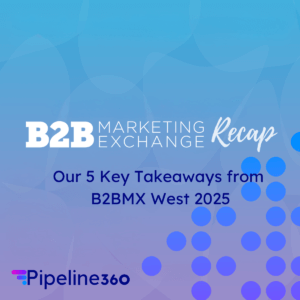Marketers exist in a climate of change with the digital landscape forever melting existing best practice models and emboldening buying groups towards self-sufficiency.
Amid the upheaval, there are two constants — budgets shrinking, or stagnating, and regulatory bodies tightening loopholes that allow marketers to easily target new business. The challenges of the job are not only changing, they’re getting more complicated, and harder to overcome. Now, B2B marketers are being told to brace themselves for the “cookiepocolypse”. The alarm bells have long sounded, but taking shelter isn’t an option. In the second half of 2024, it’s due to hit — ROI.
Marketing teams count on cookies – 75% share of marketers are reliant on third-party cookies worldwide. Apple’s Safari and Mozilla Firefox have already blocked third-party cookies, but now it’s Google’s turn. This is the big one as more than six in ten people use Chrome to browse the internet.
Increasing consumer concern has led to the expansion of data privacy regulations such as the California Consumer Privacy Act (CCPA) and the European Union’s ePrivacy Regulation — designed to streamline some of the EU’s internet privacy regulations under GDPR — and, in turn, further unsettled marketing teams.
- 80% – of internet users say the benefits of companies collecting data about them do not outweigh the risks
- 44% – of internet users say brands using their data in advertising and marketing “often feels invasive” (Source: Merkle)
But, much like when the tabloids warn of asteroids hurtling towards Earth, the “cookiepocolypse” isn’t something B2B marketers need to panic over. It won’t be fatal. By using data-driven insights to support your account segmentation strategy, B2B marketers will soon forget all about cookies.
Phew!
Now that we’ve eased your anxieties, let’s better understand how the cookie will crumble marketing efforts so you can be clear on how best to implement a solution. First, the basics.
Cookies are a marketer’s best friend – But now you need to go cold turkey
Cookies are helpful bits of code which collect information about you, and the topics you search for, as you browse the internet, and, for marketers, make targeting you with relevant information much easier. There are two types of cookies, first-party and third-party.
First-party cookies are owned and placed by the publisher of a website, and collect data about visitors and their buying journey for the sole use of that organisation.
Third-party cookies are placed on host websites by separate (third-party) organisations, such as social media and advertising networks and can collect data on visitors’ behaviour across multiple websites. This info allows organisations to compile behavioural profiles of individual buyers. While useful for optimising online buying experiences, this data is much less helpful for effective target account segmentation.
As marketers move to a post-cookie landscape — and many are already preparing: 59% share of businesses are accelerating readiness for a cookie-less future (Source: Statista) – account segmentation will become key to unlocking precision targeting. So, how does it work and why will it save us from the cookie-apocalypse?
Bin the cookies, crunch the data, convert the best prospects with account segmentation
When the cookie-era crumbles, B2B marketers need to approach account segmentation with a big-picture view.
Account segmentation is about identifying unique audience segments through common characteristics. By understanding similar account traits, needs and behaviours, marketers can connect more effectively with buyers, and target those they’re most likely to convert. 85% of global data and analytics decision-makers use customer segmentations (Source: Forrester)
Account segmentation relies on three key principles: Market attractiveness (accounts most likely to spend on your solution), strategic fit (companies that align to your company’s strategy and create sustainable revenue) and your ability to win the account. Two broad approaches should be used to build out account segments: qualitative and quantitative.
The former requires marketers to look at key internal and external data to define “best fitting” accounts to target. For the latter, marketers can analyse historic internal data for cohort similarities, lifetime customer value (LTV), and customer acquisition cost (CAC) insights to calculate the most profitable accounts to target. Used together marketers can create an ideal customer profile for segmentation.
Qualitative segmentation analysis
B2B marketers can use both internal data — your company’s own — or external (sources include third-party databases, external firms, and industry or government market research) to build account segments. External data to gather and assess for segments include market trends, category spend, use cases and competition.
- Trends: Are there developments that will make accounts more likely to spend with you; are there regulatory issues driving spend?
- Category spend: Are buyers spending money in your company’s category? Has the level of spend increased or decreased?
- Use cases: Are your solutions critical for buyers within these accounts, or just a “nice to have” option?
- Competition: Are you the best option? When segmenting external data be sure to select criteria easy to identify, but also look beyond the obvious, like, company size, industry type. These are not always the best ways to identify differences.
External data is great, but don’t look past the info you already have for account segmentation. Operations can pull data from CRMs and automation platforms to gain insight into account segmentation differences.
Key data to look at while developing account segments includes:
- Solution gaps: Does your product remedy the accounts problems?
- Expertise: Does your company understand the needs of the target accounts and everything the buying group needs to complete its journey and convert?
- Messaging: Is there tailored, relevant messaging for the different segments and personas within accounts?
- Sales readiness: Are they aligned, ready and equipped to engage?
- Marketing database: Does marketing have access to the account segment data they need?
When analysing external and internal data for segmentation, its crucial sales and marketing work together to ensure the right segmented criteria is prioritised.
Quantitative segmentation analysis
Cohort analysis is a type of behavioural analytics that helps you see what a sub-section of your existing customers — a “cohort” — is doing and is useful for account segmentation as it can provide a data blue-print for best practice. To use cohort analysis for account segmentation, first define the cohort — groups of accounts or customers — by characteristics, then gather relevant account data, such as transaction history or engagement metrics, relevant to your business.
Decide on the criteria you want for segmentation — such as average contract value (ACV), or customer lifetime value ( LTV), then create cohorts accordingly. These groups can then be analysed over time using metrics like revenue, retention or customer satisfaction, to identify trends which can be used to attract new accounts.
By using cohort analysis for account segmentation, marketers can better understand customers, improve retention, increase revenue, and make informed decisions about resource allocation and marketing efforts.
First, work out how much the customer’s lifetime value is and the cost of acquiring the account, then rank them: High (valuable, profitable), Moderate (positive ROI, but lower profitability) and Low. Next, segment the accounts, by focusing on winning accounts likely to offer the highest LTV relative to the cost of acquiring them. Then, as always, review and adjust segments based on changing LTV/CAC ratios.
That might sound like a lot of work, but really it isn’t. It’s just getting to know potential customers and whether it is worth pursuing them. Its data curation, identifying similarities, aligning needs with solutions, and asking basic questions: are they worth the time and money?
We’ve all got a sweet tooth for cookies, after all they did work, we didn’t have to, all on their own. But segmentation, done right, offers so much more. It isn’t just insight into behaviour online, it’s a bird’s eye view of new business, with probability factored in.
So don’t fret over the “cookiepocalypse”, it’s going to pass right on by and you won’t even notice.
For more information on winning new business without cookies, download our eBook here.






